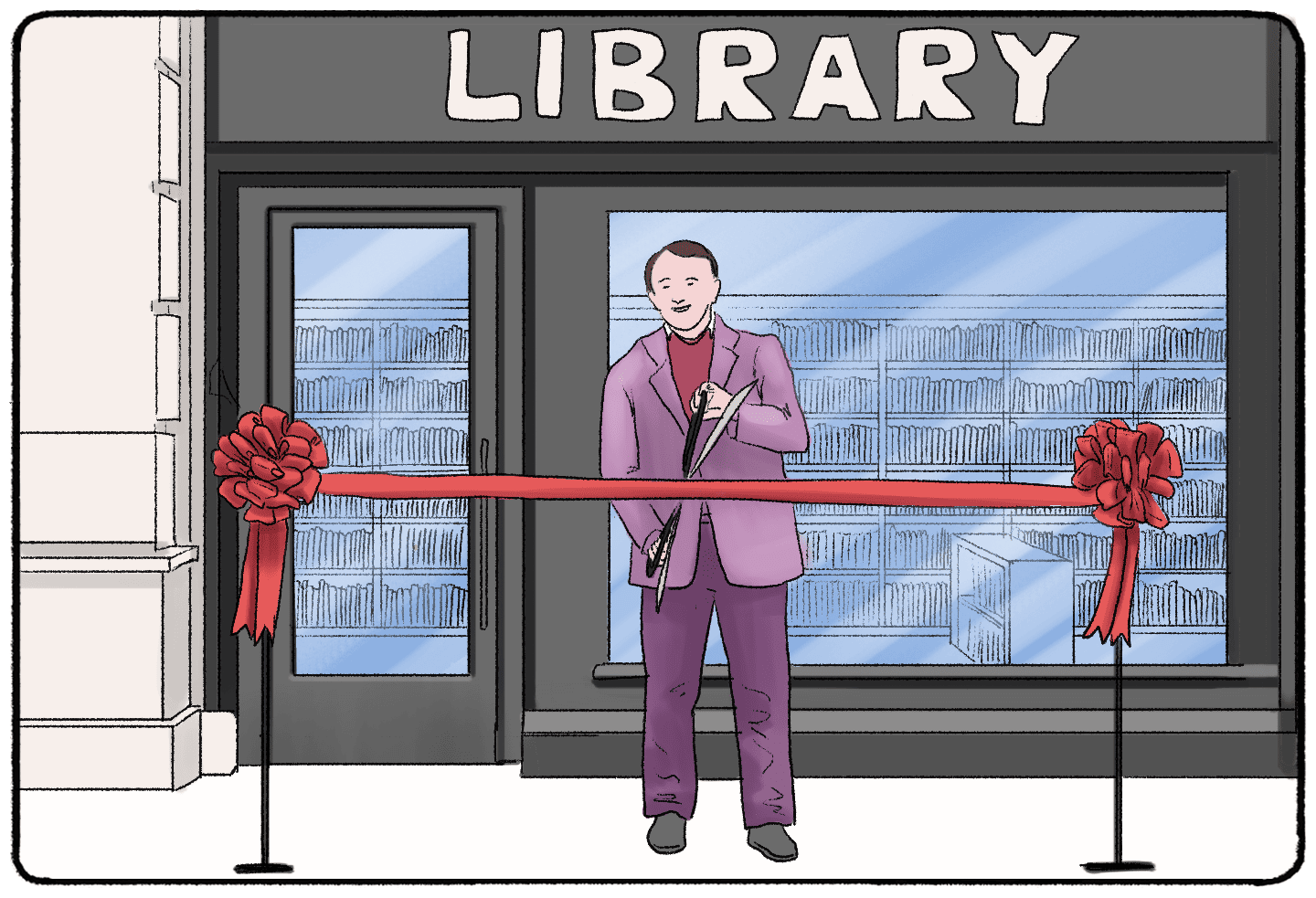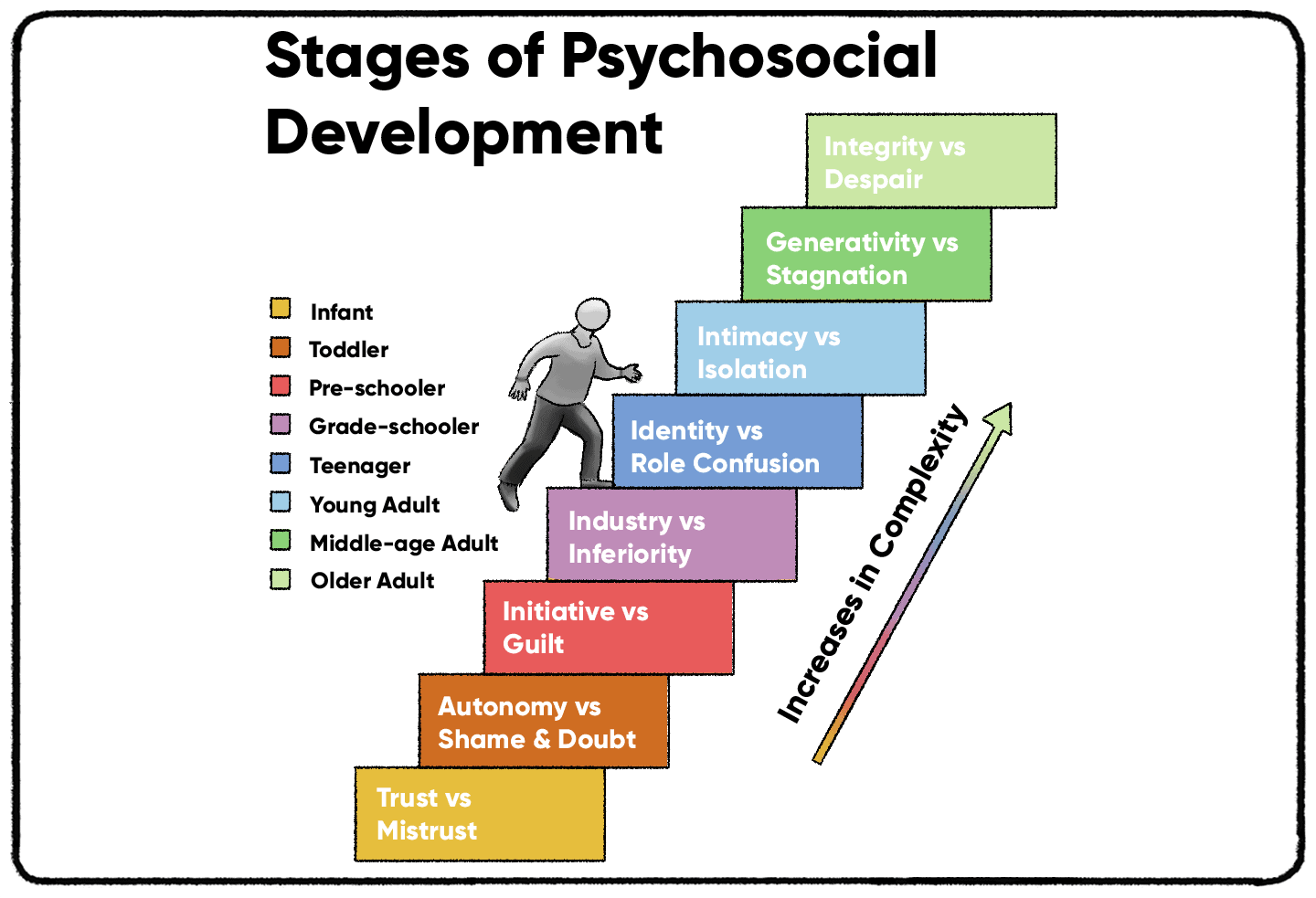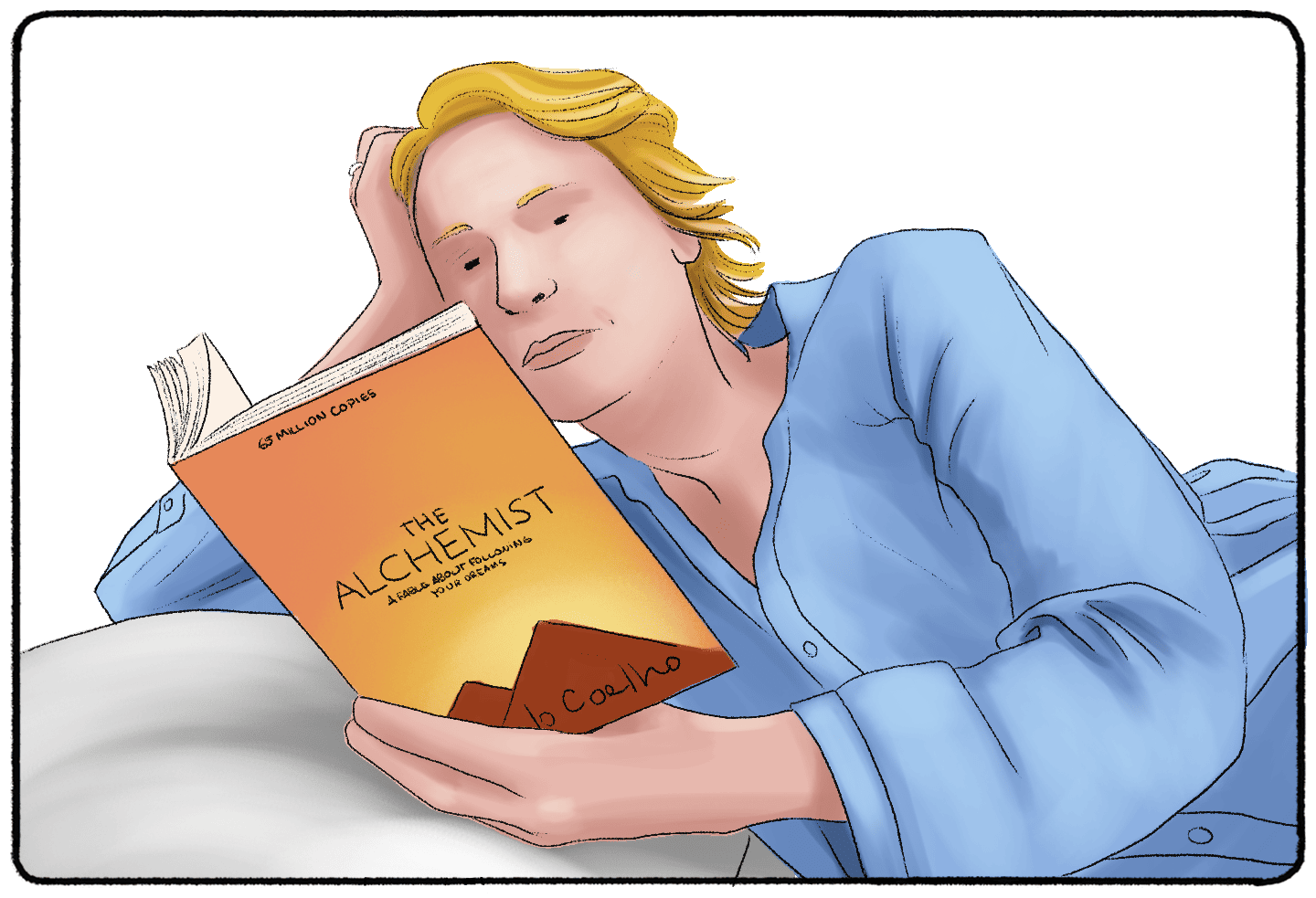What legacy do you want to leave behind? It's okay if you don't know yet. According to German psychologist Erik Erikson, a person really starts to think about their legacy between the ages of 40-60. During this stage of a person’s life, they enter a crisis: generativity vs. stagnation.
What Is Generativity vs. Stagnation?
Generativity vs. stagnation is the seventh crisis a person experiences throughout social development. It follows the crisis of intimacy vs. isolation. People who successfully move through the sixth stage have a community that brings them joy. This could include a spouse, group of friends, family unit, etc.

Generativity vs. Stagnation Age
According to Erikson, people enter the generativity vs. stagnation crisis between the ages of 40 to 60. In the “typical” expectations society placed on people while Erikson did this research, people at this age were married with older children. Grandchildren may already be on the way!
What Happens During Generativity vs. Stagnation?
In the seventh stage, the person looks beyond the generation they know. They start to think about the next generation. Parenthood is a big event in the generativity vs. stagnation stage (for those who become parents.) With a new generation starting to enter the identity vs. role confusion stage, people in this stage begin to reflect on their lives and think about what they are leaving for the next generation. This is the definition of generativity. Erikson is credited for using this term first.
If people feel good about what they leave to the next generation, they will feel satisfied and proud. If a person does not feel good, they might feel embarrassed. Like the stages before, failing to complete the seventh stage will make things harder in the last stage of social development.
Psychologists have discovered that this stage comes with other crises, but they all revolve around the same basic idea of leaving behind a legacy:
- Inclusivity vs. exclusivity
- Pride vs. embarrassment
- Responsibility vs. ambivalence
- Productivity vs. inadequacy
- Parenthood vs. self-absorption
- Honesty vs. denial
The Virtue of Generativity vs. Stagnation
The basic virtue in this stage is care. We care for the things and people that will outlive us. We take responsibility for the things we care for and help to build them up in a productive manner. When we see the results of our efforts, we feel pride.
Are Erikson's Stage of Development Still Relevant?
Erikson's eight stages of psychosocial development, penned in the mid-twentieth century, presented a framework that many found compelling in understanding human development. However, as society has evolved, so have the life paths that individuals embark upon. The sociocultural dynamics that influenced Erikson's model have seen a transformative shift over the subsequent decades, warranting a revisitation and critique of his stages.

Diverse Life Paths: Today's society boasts a tapestry of varied life paths. The traditional sequence of finishing education, embarking on a career, marrying, and starting a family is no longer the standard trajectory for many. For instance, it's increasingly common for individuals to delay marriage or opt out of it entirely. Similarly, once a given for many adults, parenthood is now a choice made after careful consideration, with many choosing child-free lives.
Changing Socioeconomic Factors: The economic pressures of the modern era, combined with societal shifts, have contributed to these changing life paths. Rising education costs, the gig economy, housing market fluctuations, and the evolving nature of work-life balance are reshaping decisions about marriage and family.
Critics and Contemporary Theories: Critics of Erikson's stages argue that the model might be too rigid and linear to encompass the complexities of contemporary life. They propose more fluid models considering the non-linear life paths many experience. Theories like the Life Course Perspective emphasize the interplay between individual decisions and broader societal factors, offering a more nuanced take on developmental stages.
Flexibility in Erikson’s Stages: While Erikson’s model might seem anchored in a specific time frame, its core emphasis on psychosocial crises remains relevant. The key is to interpret these stages flexibly. For instance, the introspection and concerns about legacy in the generativity vs. stagnation stage can apply to those without children. It might manifest in an individual's contributions to their community, mentorship in their professions, or even artistic creations.
Cultural Considerations: Moreover, while Erikson’s model was rooted in a Western context, it's essential to note the vast cultural differences that influence life decisions globally. In some cultures, familial responsibilities and community ties play a much more significant role in shaping one’s life, which can alter how and when certain psychosocial crises come to the fore.
In sum, while Erikson's stages provide a foundational framework for understanding psychosocial development, it's crucial to approach them with a modern lens, considering the myriad of life paths and societal structures that characterize today's world.
Positive Outcomes of Generativity vs. Stagnation
Entering a crisis is not always a bad thing. At each stage of Erikson’s Stages of Psychosocial Development, the person gains something new within their struggle. For example, an infant will spend time crying for its mother, but when the mother satisfies the child’s needs, they learn to trust. This is a good thing!
Facing the conflict of generativity vs. stagnation is not a walk in the park. The fear that we will not leave behind a legacy can be crippling at times, even when we have accomplished a lot in our lives! People who resolve this crisis often use these emotions as motivation.
There is a reason that people in this age group are generally more optimistic than those in younger age groups!
Changes to Diet and Health
Around the ages of 40-60, doctors begin to recommend more vigorous health checks. Women should start getting mammograms every two years, starting at age 50. Men should get annual prostate exams at 50. All people should begin getting colonoscopies every 10 years, starting at age 50. With higher risks of health conditions and more vigilant health checks, people in this stage often think more seriously about their health. After all, if they haven’t built the legacy they want to leave behind, they’ll have to be around so they can!
Entrepreneurship or Charity Work
People with children between the ages of 25-35 find themselves with less on their hands by 40-60. Their children may be going off to college or starting their own families. Many couples have to adjust to life as “empty nesters.”
This time as an empty nester, often allows people to explore the ways they want to leave a legacy! People can spend more time on charity work without having to chauffeur their kids around. No PTA meetings mean more time for board meetings! Entrepreneurship, hobbies, travel, and other activities may also take up an empty nester’s schedule. If they hit an age where they can retire, there is even more time to explore passions and develop new hobbies. Doesn’t this stage of life sound pretty great?
Resolving Relationships or Creating New Ones
Legacy isn’t just about what people will remember about you - it’s about who will remember you! Just as the generativity vs. stagnation stage offers a chance to take control of your health, it also offers a chance to take control of your relationships. Friends, family, and other social circles at this age offer more benefits than just people to see and memories to make. People with tight social networks are likelier to stay mentally sharp and physically healthy. Taking the extra time to reconnect with friends or form networks within charity organizations is a great way to ensure that you create a lasting legacy and stick around long enough to go through the last stage in Erikson’s stages of psychosocial development.
How Is This Crisis Resolved?
People complete this stage when they feel confident that they have left their mark on the world – that they have done something that will outlive them. That could be the creation of a family or the creation of a company. It would be a big charitable contribution or the work hours volunteering for a cause. Creating and nurturing generations of people is one way to feel fulfilled during this stage in your life.
Example of Generativity vs. Stagnation

Have you ever read The Alchemist?
The classic book tells the story of a boy who abandons his life as a shepherd to follow his Personal Legend. The central theme of the book is following your Personal Legend. After all, “The closer one realizes his Personal Legend, the more that Personal Legend becomes his true reason for being.”
The boy in the book is young when he learns about his Personal Legend, but he is showing all the signs of a person in the Generativity vs. Stagnation stage.
The Psychological Underpinnings of Erikson's Stages
To understand why Erikson’s stages occur when they do in a person’s life, it’s crucial to consider the interplay between biological, psychological, and sociocultural factors. Each of Erikson's crises mirrors significant transitional periods in human life, deeply rooted in our biology and society.
Biological Foundations
- Neurological Development: Brain development and maturation significantly shape our capacities for reflection, abstraction, and social interaction. As our brains mature, our ability to introspect, empathize, and think critically about our lives and relationships evolves. By the time individuals reach the generativity vs. stagnation stage, they have acquired a wealth of experiences, and their brains have reached full maturity, allowing deeper introspection about legacy and meaning.
- Hormonal Changes: The mid-life period, typically marked by generativity vs. stagnation, often coincides with significant hormonal shifts, like menopause in women. These shifts can bring about reflections on aging, fertility, and one's place in the familial lineage.
Sociocultural Factors
- Societal Roles and Expectations: Cultural norms and expectations influence our developmental trajectory. The traditional expectation for individuals in their 40s and 50s has been to be well-established in careers, have grown children, and begin considering retirement. This societal structure guides individuals toward reflection on their contributions and legacies.
- Changing Social Dynamics: Parents often experience the "empty nest" syndrome as children grow up and become independent. This shift in the daily role can lead to introspection about one's accomplishments and the future.
- Cultural Reverence for Elders: In many cultures, elders are seen as the bearers of wisdom and tradition. This cultural expectation can prompt individuals to consider what wisdom and knowledge they will impart to younger generations.
Linking with Other Developmental Theories
Other developmental psychologists, like Jean Piaget and Lawrence Kohlberg, have also emphasized the importance of age-specific challenges. For instance, Piaget's formal operational stage, where abstract thinking becomes prominent, aligns with Erikson's identity vs. role confusion stage. Kohlberg's stages of moral development similarly tie moral reasoning capabilities to age and cognitive development.
The specific crises in Erikson’s stages are natural reflections of the biological and sociocultural junctures we face at different ages. They are not merely arbitrary markers but are deeply intertwined with our evolving selves and changing contexts.
Is This a Midlife Crisis?
Erikson coined the term “identity crisis,” but did he see the generativity vs. stagnation stage as a “midlife crisis?”
Not exactly. Each stage of Psychosocial Development involves a crisis, starting with Trust vs. Mistrust in the first few months of an infant’s life. Things feel like a crisis until the stage is completed successfully: the infant feels that they can trust the world, the adolescent feels like they have a solid identity, etc.
Many studies show that people are more satisfied and happier in their 40s than in their 20s and that getting older generally makes people happier. While psychologists are still debating the “U-shape” model of happiness, many agree that the “midlife crisis” is caused by things other than just turning 40.
A person experiencing a “midlife crisis” may not be at a point where they feel they have left their mark on the world. Big life changes (divorce, loss of a job, becoming an “empty nester”) may also contribute to these feelings. This is often why people experiencing a “midlife crisis” will go out and make a big purchase - the spontaneity will give them a sense of accomplishment (even if it is brief.)
One-time actions will not move a person along this stage successfully. It takes hard work, passion, and gratitude for a person to feel that they have created a legacy.
Ways to Avoid A “Midlife Crisis” and Experience Generativity
If you or someone you know is starting to feel blue about the mark they are leaving on the world, it’s important to keep moving. To feel as though you have left a mark on the world, you’ll need to get out there and do the things that make you feel accomplished. Volunteer at a charity. Quit the job that is wasting your time. Spend more hours a day with your family and watch your children grow up. You may need to step back and re-evaluate what it means to impact future generations and leave a legacy. What do you care about?
Whether you, a spouse, a friend, or a family member is journeying through Erikson's Generativity vs. Stagnation phase, understanding and supportive actions can significantly affect how one navigates this critical period of life. Here's how you can guide someone or even yourself through this stage:
Affirm Their Impact: Even if they feel they've made no significant mark in the world, remind them of their unique influence on the lives of others. Their legacy is not just about grand achievements; it's also about the little moments, the lessons taught, and the love shared. Celebrate these with them, and make them realize how they have shaped the world in their own way.
Champion Their Independence: Encourage them to pursue new passions, rediscover old hobbies, or start new relationships. If they wish to embark on an adventure or take a new course, be their cheerleader. They may need a little push or assurance, but it could open up new dimensions in their life once they get going.
Involve Them Actively: Ensure they feel an integral part of the family and community. Update them about plans, ask for their opinions, and, more importantly, involve them in decision-making. This boosts their morale and assures them that they are valued and essential.
Promote Wellness: Encourage a balanced lifestyle focusing on physical and mental well-being. This is a stage where one might face health challenges, and a proactive approach towards health can improve their quality of life and self-esteem.
Foster Connection: This stage often raises questions about one's legacy and mark on the world. By fostering deeper connections, whether it's through regular conversations, shared experiences, or simply spending quality time, you can help them realize that their legacy lives through the relationships they've built and nurtured.
Seek External Support if Needed: If they exhibit signs of severe stagnation or distress, consider seeking professional help. Therapists or counselors can provide additional tools and perspectives to navigate this stage.
By embracing these strategies, it becomes easier to transition through the Generativity vs. Stagnation phase, finding fulfillment and leaving a meaningful legacy.
Fortunately, this does not have to be done overnight. The generativity vs. stagnation stage lasts for two decades. This can be an exciting journey, but no journey is without a few doubts or bumps in the road. If you’ve completed the previous stages, you should have a support group and a strong identity to help you explore during this period. And might I recommend reading The Alchemist?
